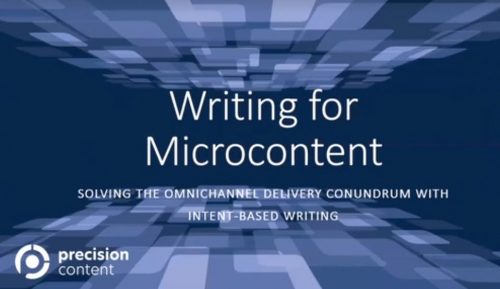- How Dynamic Content Delivery generates value from your existing content, no matter the writing tools and methods you are using now
- How to achieve quick wins and build a fast ROI to gain support from your Execs for your content project
- How to optimize your project to move to structured authoring and make it a success
-
January 12, 2022 Moving to structured authoring and implementing a CMS are critical projects that will generate long-term efficiency gains and significant savings. But before you get there, there are great hurdles to overcome. First and foremost, there's winning budget approval from your execs, who will have a singular focus on risk and ROI. Second, you need to maintain a high level of commitment and buy-in from those executives over the years that re-engineering of content production can last. Too many content restructuring projects fail or don’t even start because they cannot demonstrate a quick and tangible return on investment - and this is where Dynamic Content Delivery changes the game. Dynamic Content Delivery provides outstanding content experiences to your users and creates immediate value for your company without requiring a big bang in your writing process. It earns you internal support, money, and time you can leverage to optimize your content restructuring process. In this webinar, you will learn:
-
May 19, 2021 Omnichannel experience is setting the bar for customer expectation and it’s putting new and increasingly complex demands on your business to deliver the right information where your customers need it. Writing for the web is not writing for omnichannel. Preparing your content for emerging technologies requires new approaches to content creation and delivery. It requires a microcontent strategy. Robust content management technology is certainly part of the solution, and your organization will be tempted to invest in new tools for chatbots and voice. However, before you go ahead and fill yet another content silo with zettabytes of information, instead make enhancements to the content creation programs you already have. Microcontent is the next evolution in structured authoring and will open new channels for your content while improving delivery across existing channels. In this session, we will focus on the missing link in a successful microcontent strategy: an intent-based writing methodology. We will highlight some key concepts that will help you to start looking at your content through an omnichannel lens. Presented by: Mike Rowlinson is the VP of Training & Content Services at Precision Content. Mike has been working in the technical communications industry since 2005. His core belief is that great content enables great companies. Mike’s division develops and delivers engaging and effective training and transformation engagements including the recent completion of the firm's eLearning product, the 15 modules self-paced, Precision Content® Writer Training. The training enables writers to create effective content so that staff and customers alike can find what they need and understand what's required quickly and efficiently.
-
Recorded on October 26, 2023

Comparing XSL-FO and CSS formatting is not straightforward. XSL implementations are not standing still: XSL formatters are still incrementally improving even though the XSL Recommendation has not been updated since 2006. CSS is definitely not standing still, although some of the modules most relevant to paged media are advancing slowly, if at all, and some paged media features have been removed in more recent Working Drafts.
This will be a high-level view of the differences and similarities between XSL-FO and CSS, based on an extensive new analysis by Antenna House while producing the book “XSL-FO/CSS Comparison” that itself is formatted identically using both XSL-FO and CSS. It also covers some of the features of how the two versions are produced.
Presented by Michael Miller
Michael Miller is Vice President of Antenna House, Inc., a company that has developed one of the leading standards‐based (XSL‐FO and CSS) document formatting software products on the market today. Michael has a degree in Printing Engineering and Management and has been involved in high‐end composition, document formatting, and document management for over 40 years. He has an extensive background with structured data, including SGML, XML, S1000D, and DITA. During his career, he has worked in Europe and North America and has been involved in the implementations of some of the largest fully automated publishing and document formatting projects.



